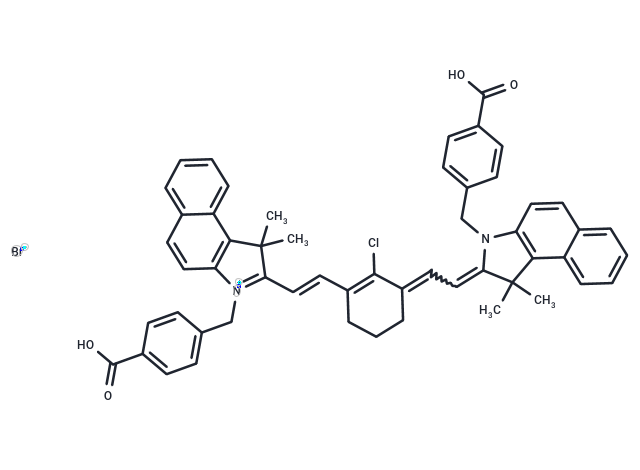Shopping Cart
Remove All Your shopping cart is currently empty
Your shopping cart is currently empty
IR-825 is a near-infrared dye. IR-825 nanoparticles showed pH-dependent fluorescence emission and excellent near-infrared irradiation of cancer cells targeted in vitro to provide cytotoxicity. IR-825 nanoparticles showed efficient tumor homing together with rapid renal excretion behaviors, as revealed by MR imaging and confirmed by biodistribution measurement.

| Pack Size | Price | USA Warehouse | Global Warehouse | Quantity |
|---|---|---|---|---|
| 1 mg | $293 | 4-6 weeks | 4-6 weeks | |
| 5 mg | $722 | 4-6 weeks | 4-6 weeks | |
| 10 mg | $987 | 4-6 weeks | 4-6 weeks | |
| 25 mg | $1,520 | 4-6 weeks | 4-6 weeks | |
| 50 mg | $1,980 | 4-6 weeks | 4-6 weeks | |
| 100 mg | $2,500 | 4-6 weeks | 4-6 weeks |
| Description | IR-825 is a near-infrared dye. IR-825 nanoparticles showed pH-dependent fluorescence emission and excellent near-infrared irradiation of cancer cells targeted in vitro to provide cytotoxicity. IR-825 nanoparticles showed efficient tumor homing together with rapid renal excretion behaviors, as revealed by MR imaging and confirmed by biodistribution measurement. |
| Animal Research | I. Application of photodynamic therapy 1. Material preparation (1) IR-825 dye: usually dissolved in an appropriate organic solvent (such as DMSO), the concentration is generally in the range of 1-10 μM. (2) Cell or animal model: use cultured cancer cells (such as HeLa cells) or animal models. (3) Light source: use a laser light source with a specific wavelength (such as an excitation wavelength of about 800 nm). (4) Culture medium or injection solution: for cell experiments, use conventional cell culture medium; for animal experiments, use physiological saline or appropriate buffer. 2. Experimental steps (1) Cell experiment: dissolve IR-825 and add it to the cancer cell culture medium, incubate for a certain period of time (usually 2-4 hours), then irradiate the cells with a light source with a specific wavelength (excitation wavelength of about 800 nm), and use the MTT method, cell viability kit, etc. to detect cell survival rate. (2) Animal experiment: Inject IR-825 photosensitizer into animals by intravenous injection or local injection, select the appropriate time for illumination, and observe indicators such as tumor size and tissue pathological changes after illumination. (3) ROS detection: Use fluorescent probes (such as DCFH-DA, DHE, etc.) to detect reactive oxygen species (ROS) produced under illumination. 2. Fluorescence imaging 1. Inject IR-825 into animals or add it to cell culture medium. 2. Use appropriate fluorescence microscopes or imaging equipment to observe its distribution in the body or cells. |
| Molecular Weight | 824.42 |
| Formula | C54H48ClN2O4 |
| Cas No. | 1558079-49-4 |
| Smiles | [Br-].CC1(C)C(=C\C=C2/CCCC(\C=C\C3=[N+](Cc4ccc(cc4)C(O)=O)c4ccc5ccccc5c4C3(C)C)=C2Cl)N(Cc2ccc(cc2)C(O)=O)c2ccc3ccccc3c12 |
| Relative Density. | 1.31g/cm3 |
| Storage | keep away from moisture,keep away from direct sunlight | Powder: -20°C for 3 years | In solvent: -80°C for 1 year | Shipping with blue ice/Shipping at ambient temperature. |
| Solubility Information | DMSO: Soluble |
| Size | Quantity | Unit Price | Amount | Operation |
|---|

Copyright © 2015-2025 TargetMol Chemicals Inc. All Rights Reserved.